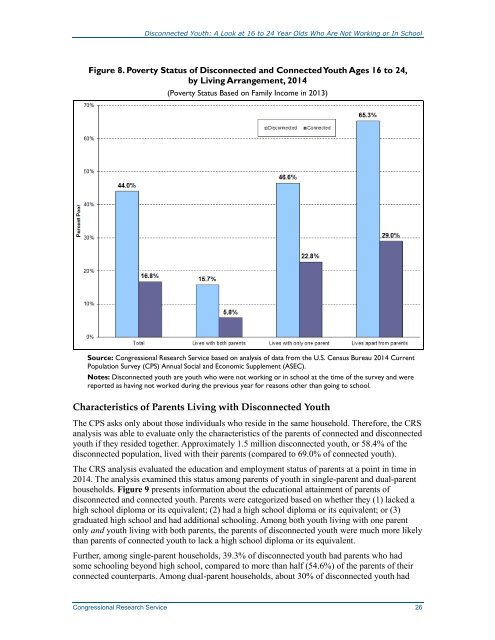Opportunity Youth: Disenfranchised Young People
Opportunity Youth: Disenfranchised Young People
Opportunity Youth: Disenfranchised Young People
You also want an ePaper? Increase the reach of your titles
YUMPU automatically turns print PDFs into web optimized ePapers that Google loves.
Disconnected <strong>Youth</strong>: A Look at 16 to 24 Year Olds Who Are Not Working or In School<br />
Figure 8. Poverty Status of Disconnected and Connected <strong>Youth</strong> Ages 16 to 24,<br />
by Living Arrangement, 2014<br />
(Poverty Status Based on Family Income in 2013)<br />
Source: Congressional Research Service based on analysis of data from the U.S. Census Bureau 2014 Current<br />
Population Survey (CPS) Annual Social and Economic Supplement (ASEC).<br />
Notes: Disconnected youth are youth who were not working or in school at the time of the survey and were<br />
reported as having not worked during the previous year for reasons other than going to school.<br />
Characteristics of Parents Living with Disconnected <strong>Youth</strong><br />
The CPS asks only about those individuals who reside in the same household. Therefore, the CRS<br />
analysis was able to evaluate only the characteristics of the parents of connected and disconnected<br />
youth if they resided together. Approximately 1.5 million disconnected youth, or 58.4% of the<br />
disconnected population, lived with their parents (compared to 69.0% of connected youth).<br />
The CRS analysis evaluated the education and employment status of parents at a point in time in<br />
2014. The analysis examined this status among parents of youth in single-parent and dual-parent<br />
households. Figure 9 presents information about the educational attainment of parents of<br />
disconnected and connected youth. Parents were categorized based on whether they (1) lacked a<br />
high school diploma or its equivalent; (2) had a high school diploma or its equivalent; or (3)<br />
graduated high school and had additional schooling. Among both youth living with one parent<br />
only and youth living with both parents, the parents of disconnected youth were much more likely<br />
than parents of connected youth to lack a high school diploma or its equivalent.<br />
Further, among single-parent households, 39.3% of disconnected youth had parents who had<br />
some schooling beyond high school, compared to more than half (54.6%) of the parents of their<br />
connected counterparts. Among dual-parent households, about 30% of disconnected youth had<br />
Congressional Research Service 26

















